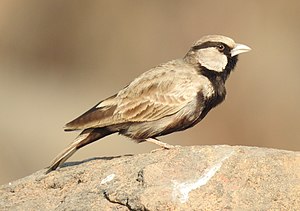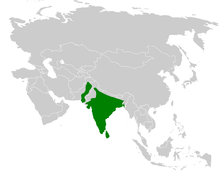Gray teller
| Gray teller | ||||||||||||
|---|---|---|---|---|---|---|---|---|---|---|---|---|

Gray teller, male |
||||||||||||
| Systematics | ||||||||||||
|
||||||||||||
| Scientific name | ||||||||||||
| Eremopterix griseus | ||||||||||||
| ( Scopoli , 1786) |
The gray teller ( Eremopterix griseus ) is a species from the lark family. It is a very small, finch-like lark with a thick, short beak. Their distribution area is on the Indian subcontinent. No subspecies are distinguished.
The IUCN classifies the gray teller as harmless ( least concern ).
Position in the genus Eremopterix
The position of the gray teller within the genus Eremopterix has not yet been clarified. Some authors think it is conceivable that the white-fronted lark forms a super-species with the brown-side liqueur . Other authors are of the opinion that the Gray Lark is most closely related to the White-fronted Lark .
features
The gray teller reaches a body length of about 11 to 12 centimeters, of which 4 to 4.6 centimeters are on the tail. The beak measures 1.1 to 1.3 centimeters measured from the skull. It weighs around 14 to 168 grams. There is a pronounced gender dimorphism .
Appearance of the male
In the male, the forehead, neck, back neck, cheeks, front neck and sides of the neck are light ash brown. The ear covers are whitish gray. A black band runs from the chin and the base of the beak over the eyes to the vertex, which is also black. The top of the body is otherwise sand-colored, the seams of the individual feathers are each a little lighter. The upper tail-coverts are yellow-brown. The underside of the body black with a brownish tinge. The arm and hand wings are dark brown with narrow yellow-brown hems. The tail plumage is blackish brown, while the middle pair of control feathers is lined with whitish to grayish brown. The sixth (outermost) control spring has a wide yellow-brown border. The beak is brightly horn-colored, the iris is brown.
Appearance of the female
The female has a sand-colored head that appears dashed through the dark pen shafts. The ear covers are brownish. The eye ring is yellow-brown, the stripe above the eye is almost invisible. The rest of the top of the body is sand-colored. The underside of the body is light isabel in color, with dark brown spots on the chest. The hand and arm wings are colored like the male. The beak is light horn-colored, the feet and claws are brownish flesh-colored.
Appearance of the young birds
Young birds initially resemble the adult female, but have light reddish brown fringes on the upper side of the body.
singing
The singing of the gray crest, which the male sings while climbing and hovering, is performed with great vehemence and consists of a series of spirited trills. The trills are occasionally interrupted by drawn out whistling tones. Overall, the singing of the gray pan is reminiscent of that of the skylark .
The male climbs almost 30 meters vertically into the air from a stone or a mound during its singing flight. It then circles, like a skylark, singing or shaking in the air. Then it can be dropped almost vertically to the ground again without landing immediately. Immediately before the ground it begins with a series of air leaps. Up to 40 jumps were counted over a distance of about 100 meters. Eventually the male lands on a stone or clod of earth with wings outstretched.
A single courtship flight lasts between three and five minutes. It is shown by the male at short intervals throughout the day.
Distribution area and habitat
The gray teller is found from Pakistan to Nepal and Bangladesh. It also inhabits the area of India and is absent only in the mountains of West India. The northern limit of distribution here is the Himalayas . It is also found in Sri Lanka. The gray teller is a resident bird .
The habitat of the gray teller is stony fallow land that is sparsely populated with scrub and dry grass. It also occurs in rice stubble fields and in dry river beds. The altitude distribution is limited to a maximum of 1000 meters.
Way of life
The gray teller eats seeds and invertebrates such as ants, weevils and other insects.
The reproductive biology of the gray teller has so far been little studied. It can breed all year round, but it breeds on the Indian subcontinent mainly in the period from February to September and from May to June in Sri Lanka.
Like all larks, the gray teller is a ground breeder. The nest is a typical lark's nest that is built out of grass in a hollow. It is laid out on the inside with finer grass, hair or threads. The inside diameter is about 5 centimeters. The clutch consists of two to three eggs. These have a cloudy white to light yellowish base color and are speckled with brown and lavender colors.
literature
- Rudolf Pätzold : The larks of the world . Westarp Sciences, Magdeburg 1994, ISBN 3-89432-422-8 .
- Rudolf Pätzold: Compendium of Larks. All the larks on earth. Jan-Schimkat-Medienpublikation, Dresden 2003, ISBN 3-00-011219-7 .




